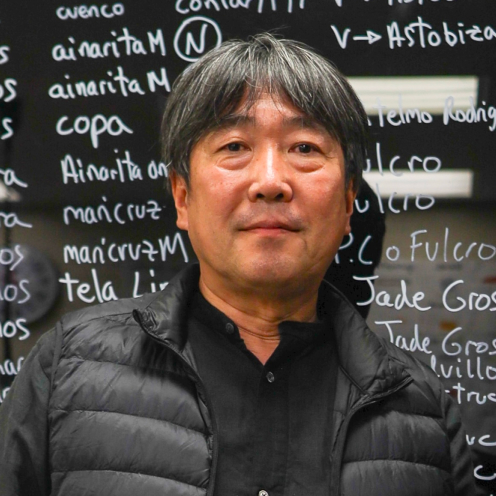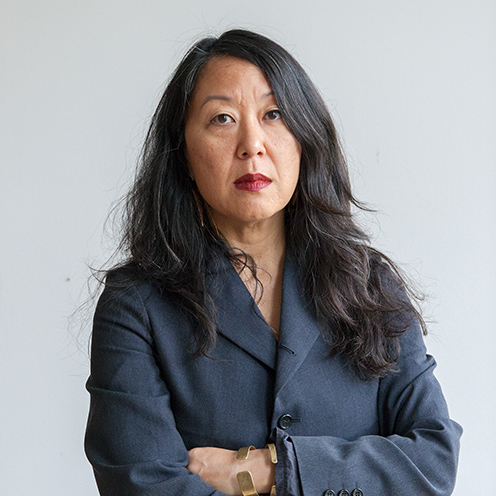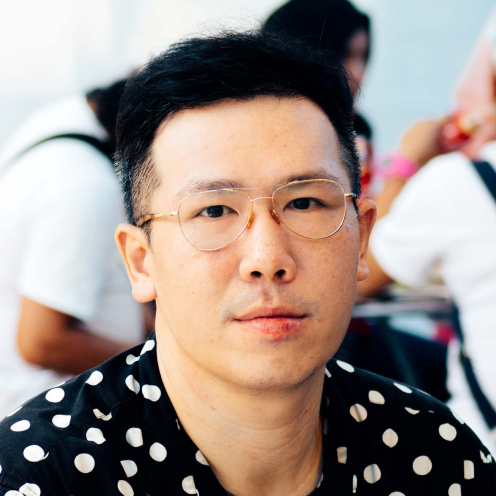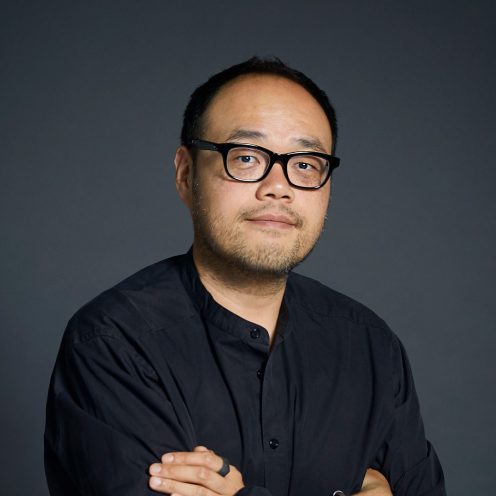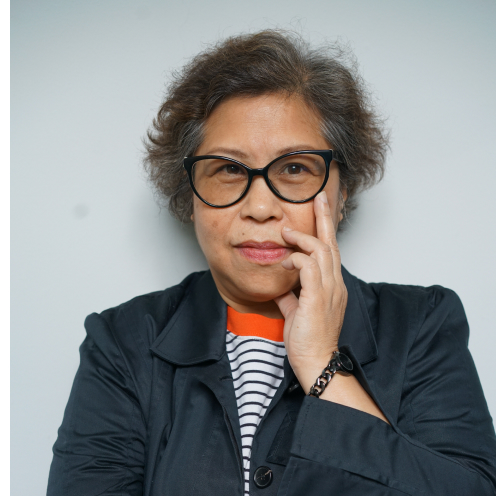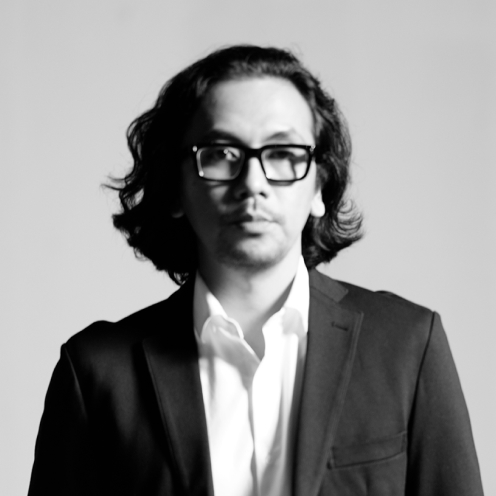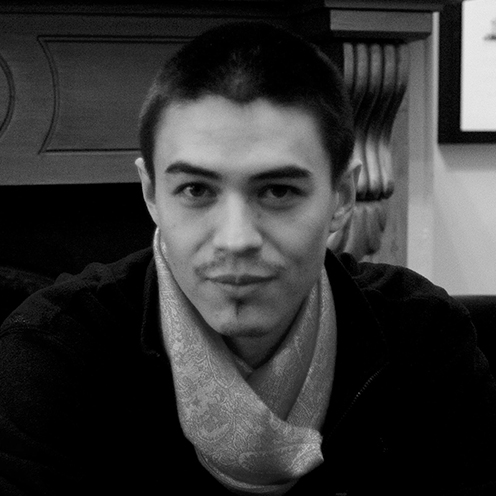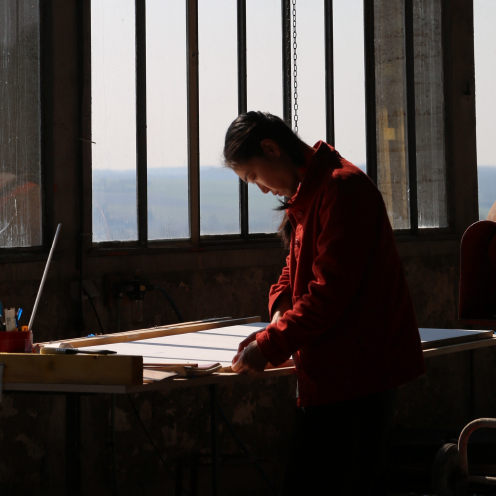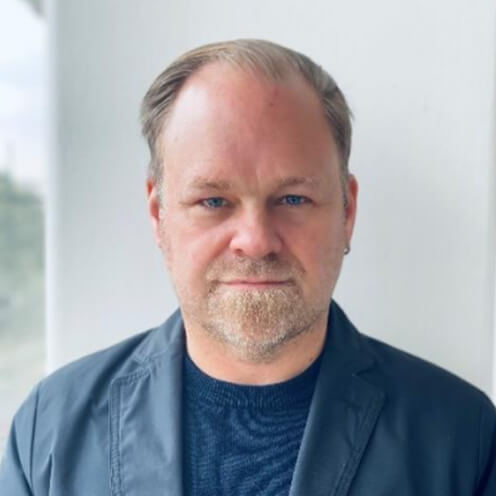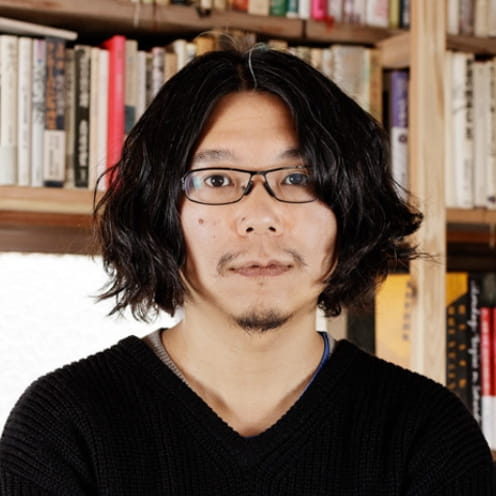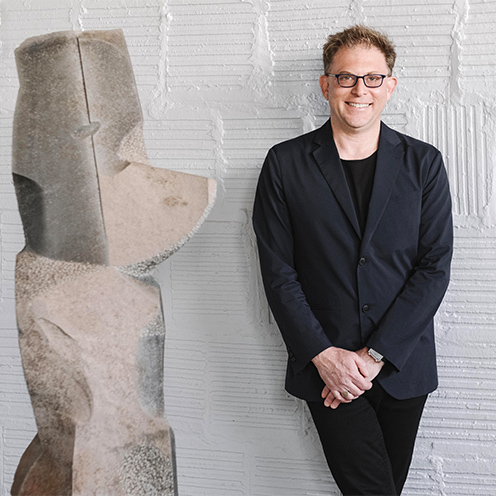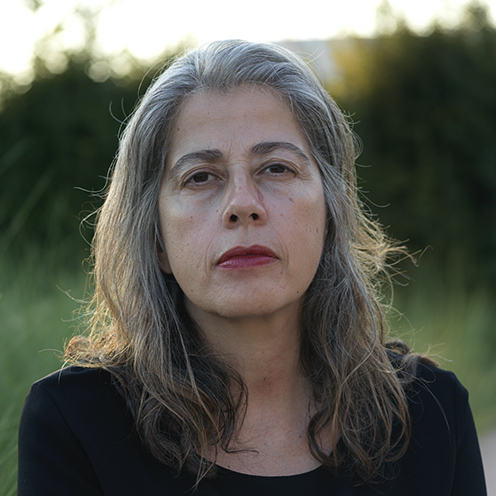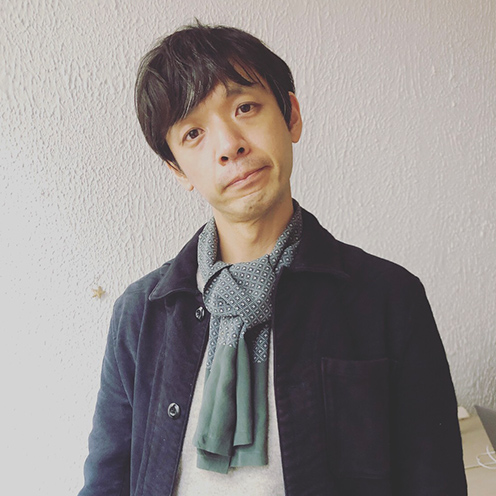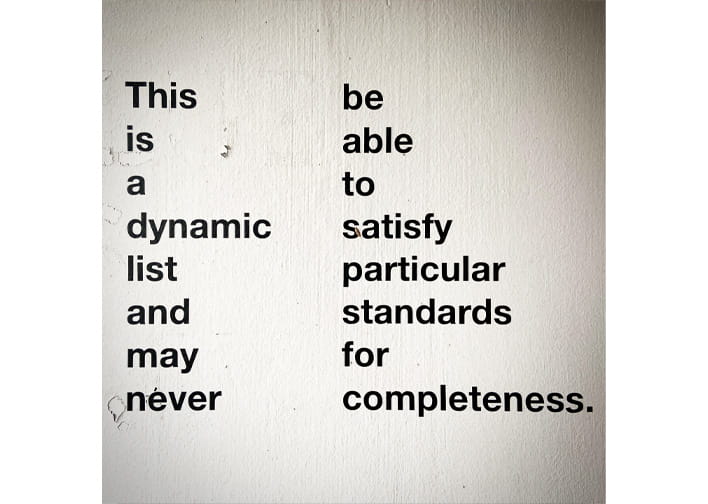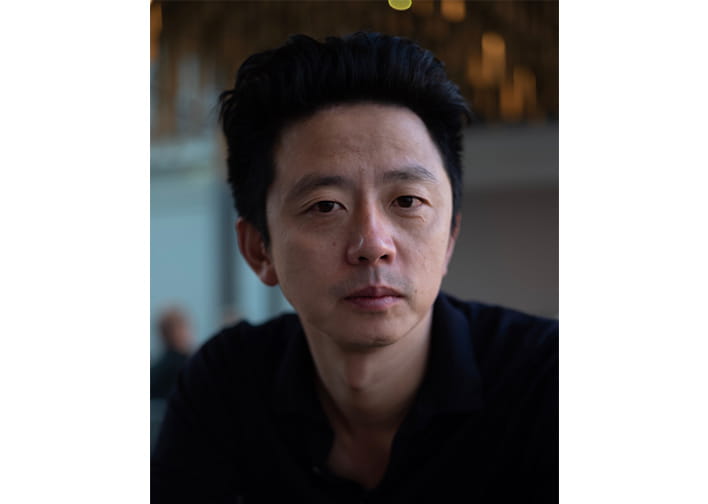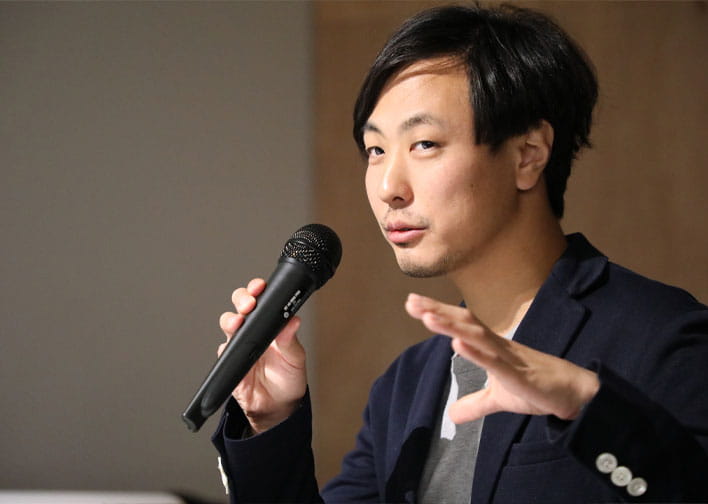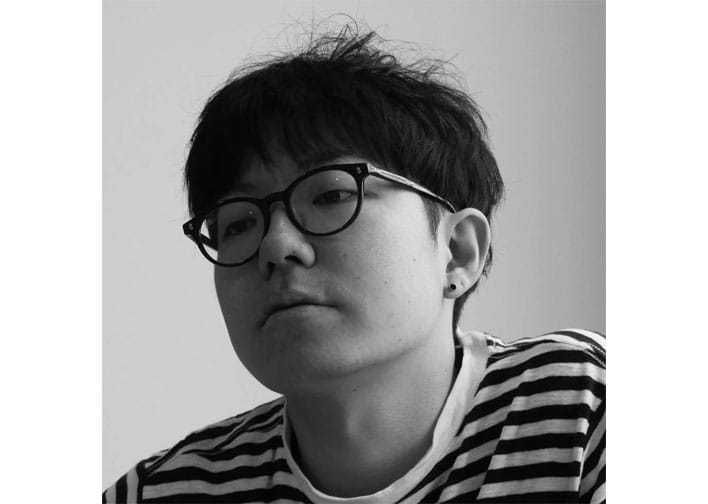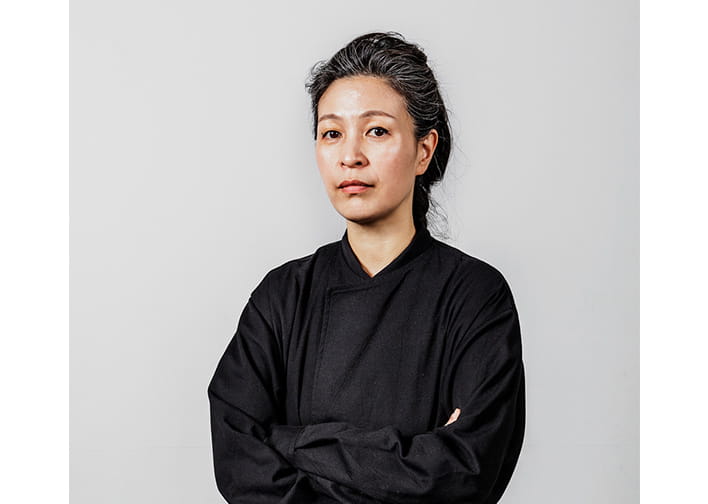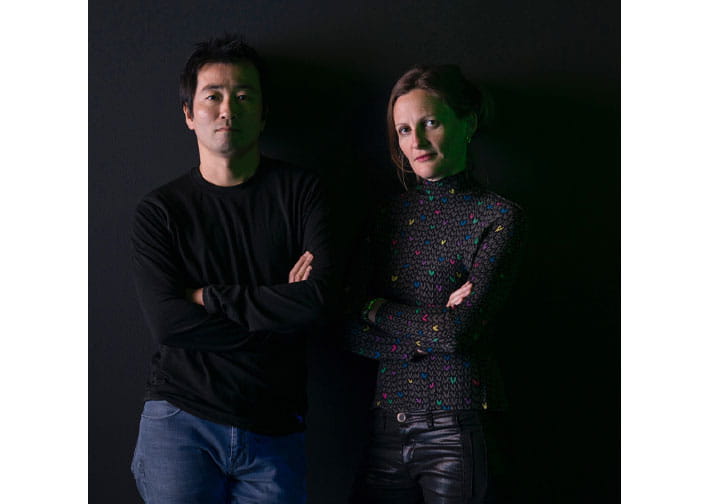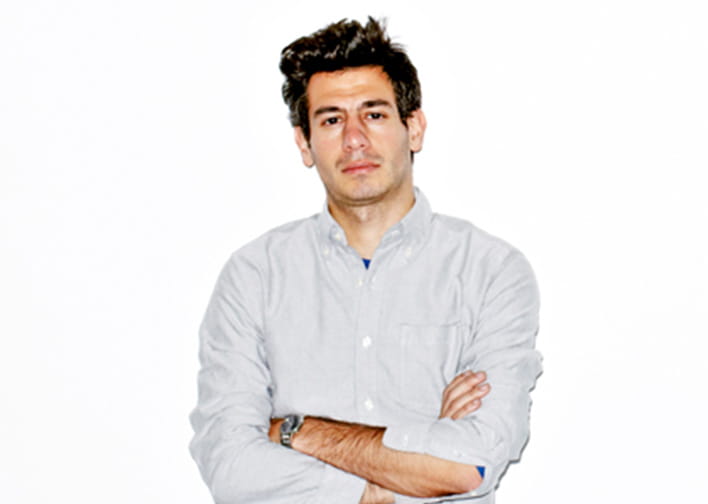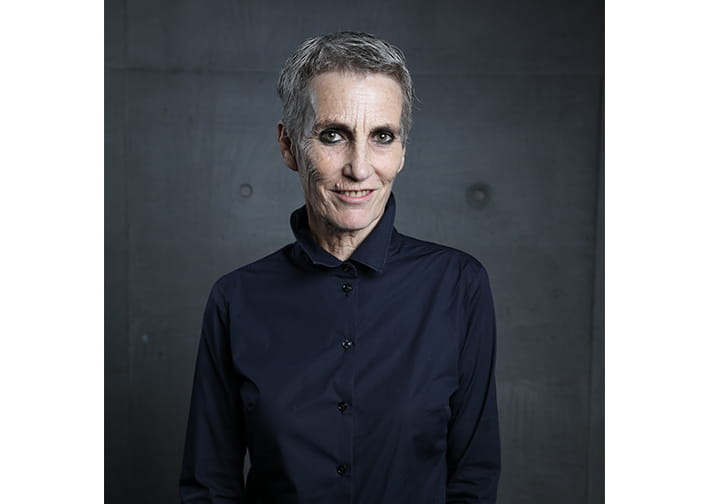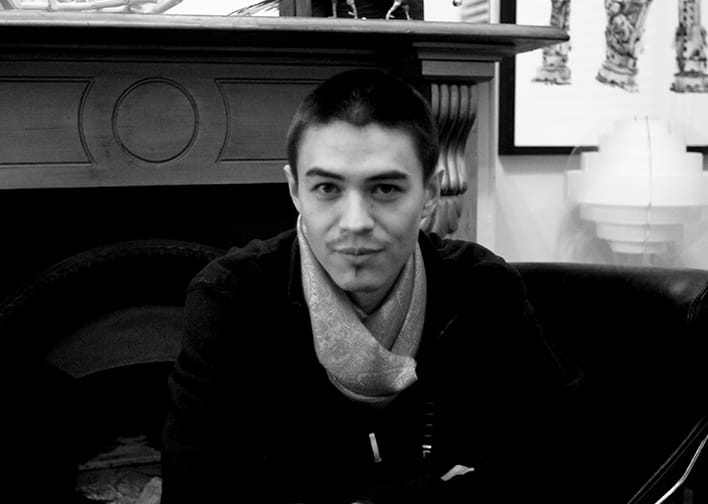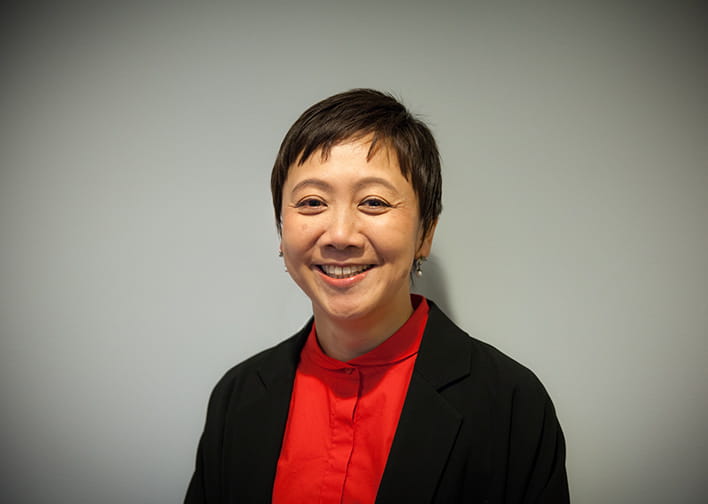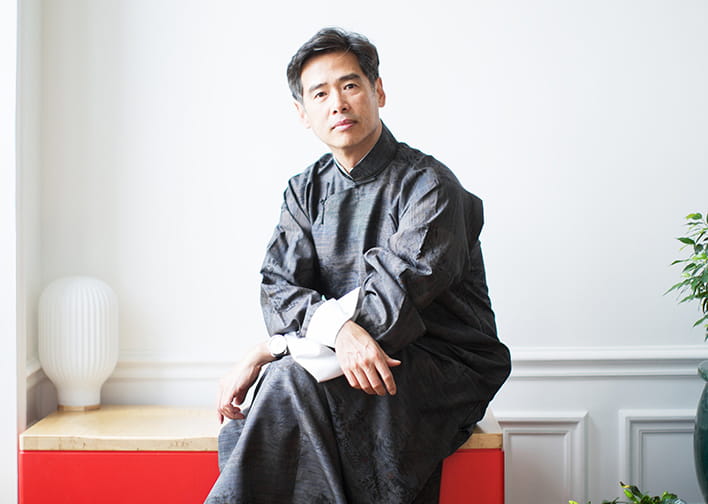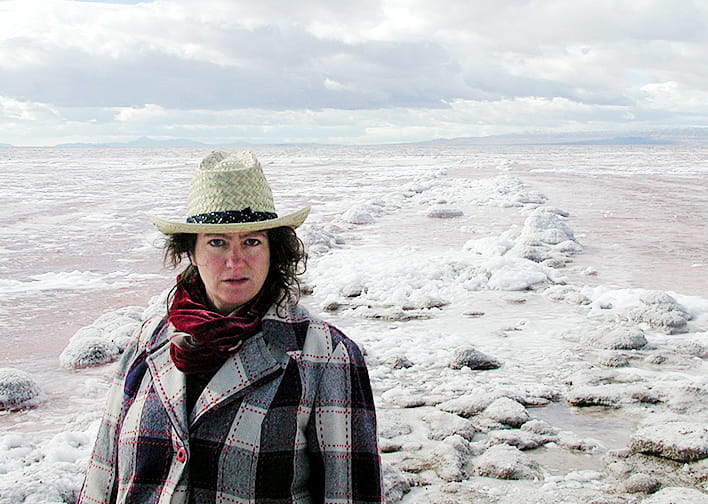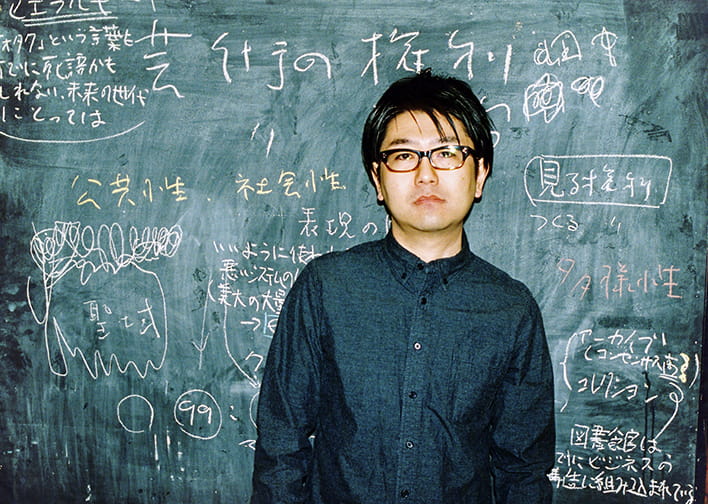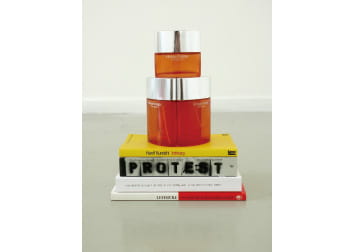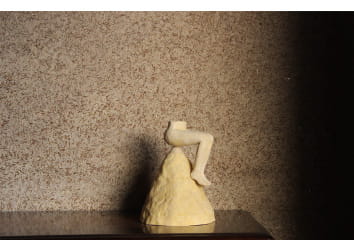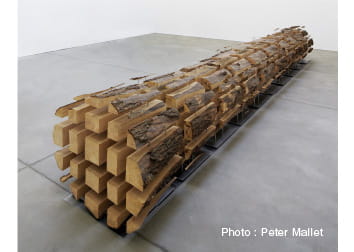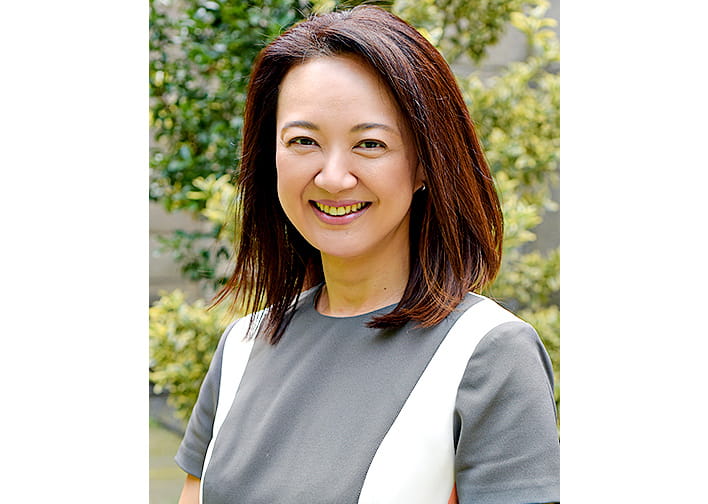On-Campus Institution
-

Institute of Contemporary Arts Kyoto(ICA Kyoto)
As a "Project-based Course" to be held from FY 2025, ICA Kyoto will take over the activities of Global Seminar, Graduate School.
Click here for information on the past activities of Global Seminar, Graduate School. *
*We are not currently accepting student applications.
-
List of Guest Lecturers for the Project-based Course "Global/Asian Studies"
Guest lecturers,2025
 Artist / Japan Michihiro Shimabuku
Artist / Japan Michihiro ShimabukuBorn in Kobe in 1969, currently based in Naha and active internationally. From the beginning of the 1990s, he has travelled to various places in Japan and overseas, creating performances and installations that consider the daily lives and cultures of people he encounters, as well as new forms of communication. Full of poetic sentiment and humor while also inspiring people in metaphorical ways, his style has gained a worldwide reputation. In recent years, he has had solo exhibitions at the Centro Botin, Santander, Spain (2024), at Museion, Bolzano, Italy (2023), and at the Nouveau Musée National de Monaco, Monaco (2021). Shimabuku has participated in group shows at Centre Pompidou in Paris and Hayward Gallery in London,and in numerous international exhibitions including Venice Biennale(2003, 2017), the São Paulo Biennial (2006), Havana Biennal (2015) and Lyon Biennale (2017). He was also a Guest Professor at the Braunschweig University of Art, Germany (2005-2006) and a Guest Lecturer at Zurich University of the Arts, Switzerland (2014-2015).
 Curator / USA Eungie Joo
Curator / USA Eungie JooEungie Joo was inaugural Curator and Head of Contemporary Art at San Francisco Museum of Modern Art; Curator of Sharjah Biennial 12: The past, the present, the possible; Director and Curator of Education and Public Programs at the New Museum; Commissioner of the Korean Pavilion at the 53rd Venice Biennale, Condensation: Haegue Yang; inaugural Director and Curator of the Gallery at REDCAT; and co-founder of the participatory space Six Months: Crenshaw. Her curatorial practice relies on sustained relationships with artists through the production of new work, activating discursive and performative platforms, and exhibition making. Joo earned her PhD in Ethnic Studies from the University of California at Berkeley.
 Artist / Taiwan Yu Cheng-Ta
Artist / Taiwan Yu Cheng-TaYu Cheng-Ta is a performance and multimedia artist hailing from Taiwan. His work consistently delves into the intersections of identity, language, politics, cultural amalgamation, and media interfaces. Through whimsical performances, he navigates the ever-evolving realm of contemporary media to examine the metamorphosis of “'self”' and “'identity.”' Since 2017, he has ventured into exploring the performative aspects of gender, contemplating both individual and collective identity, as well as the pivotal political role played by queer imagination within a media-dominated society through his event-based projects. He also formed a duo called “Watermelon Sisters” with Singaporean artist Ming Wong. In 2019, he created a fictional character known as 'FAMEME,' employing a dual identity as the cornerstone for his cross-disciplinary art practice.
Yu participated in many international art festivals, including: Taipei Biennial, Venice Biennale Taiwan Pavilion, Aichi Triennale, Performa Biennial, Shanghai Biennial, Berlin International Film Festival, Asian Art Biennial, among others. Also, he held solo screenings at Centre Pompidou in Paris and Kunsthal Charlottenborg in Copenhagen, as well as solo exhibitions at Taipei Fine Arts Museum, Kaohsiung Museum of Fine Arts and Gyeonggi Museum of Modern Art. Curator / United Kingdom Yung Ma
Curator / United Kingdom Yung MaYung is currently servicing as Senior Curator at the Hayward Gallery in London. Prior to his appointment at Hayward in November 2021, Yung was Artistic Director of the 11th edition of the Seoul Mediacity Biennale and served as Curator of the Contemporary Art and Prospective Creation Department at the Centre Pompidou in Paris, where he organised the solo exhibition HX by Cao Fei (2019), and has also co-organised the group exhibitions Chine-Afrique (2020) and Global(e) Resistance (2020 - 2021). He was previously Associate Curator of Moving Image at M+, Hong Kong (2011–16), where he was tasked to develop the institution’s moving image collection. While at M+, he also conceived the series M+ Screenings (2016–) as well as exhibitions such as Mobile M+: Moving Images (2015). He has twice served as Co-Curator of the Hong Kong Pavilion at the Venice Biennale, in 2009 with the solo presentation of Pak Sheung Chuen and 2013 with the solo presentation of Lee Kit.
 Curator / Thailand Gridthiya Gaweewong
Curator / Thailand Gridthiya GaweewongGridthiya Gaweewong is an Artistic Director and curator of the Jim Thompson Art Center in Bangkok. Her curated projects within Asia, Europe and the Americas include The Open World, Thailand Biennale, Chiang Rai (2023); Imagined Borders, the 12th Gwangju Biennale (2018); Between Utopia and Dystopia, Mexico City (2011); Unreal Asia, Internationale Kurzfilmtage Oberhausen, Oberhausen (2009); and Under Construction, Tokyo (2000–2002). Gaweewong was a guest curator of an exhibition Apichatpong Weerasethakul: The Serenity in Madness that toured six cities (2016–2020), initiated by the Independent Curators International (ICI). A 2018 fellow at the Center for Curatorial Leadership, MoMA, New York, Gridthiya is also a member of the acquisition committee for the Singapore Art Museum since 2020. Recently, she serves as a member of the Finding Committee for Artistic Direction of Documenta 16. Gridthiya was awarded the French Ministry of Culture’s Chevalier de l’Ordre des Arts et des Lettres in 2023, and Audrey Irmas Award for Curatorial Excellence from Bard College (CCS Bard) in 2025.
 Curator / Indonesia Bob Edrian
Curator / Indonesia Bob EdrianBob Edrian is a freelance art curator and writer based in Jakarta, Indonesia. His research focuses on the development of media art and sound practices in the arts. His curatorial projects include 5 Seniman | Suara | Ruang (2013), Salon Vol.1-7 (2015-2018), Bandung New Emergence Vol. 6: Listen!(2016), Intomedia (2017), Soemardja Sound Art Project (2018), International Media Art Festival Instrumenta (2018-2019), Norrm Radio‘s Sonic Philosophy (2018-2020), Orange Cliff Records‘ Audial Plane (2019-2022), Pancaran Citra Lokal (2020), Universal Iteration (2021-2023), Festival Komunitas Seni Media (2024), and Hybrid Hope: Shamanism & Technology (2024).
Guest lecturers, Global Seminar 2024
Guest lecturers
 Artist, Filmmaker / Japan Yu Araki
Artist, Filmmaker / Japan Yu ArakiAraki majored in sculpture at Washington University in St. Louis (USA) and furthered his studies at Graduate School of Film and New Media Studies, Tokyo University of the Arts (Japan). As a failed English/Japanese interpreter, his central theme has been revolving the idea of mistranslation. Recent exhibitions include venues such as Tokyo Photographic Art Museum (2024), Towada Art Center (2023), C-LAB (Taipei, 2023), Sydney Opera House (2021), Pola Museum of Art (2020), Shiseido Gallery (Tokyo, 2019), and Art Sonje Center (Seoul, 2019). His films have been screened at Institute of Contemporary Arts (London, 2021), FIDMarseille (2021), International Film Festival Rotterdam (2018, 2020) and many more. During 2017-18, he was a guest resident at Asia Culture Center in Gwangju as well as Rijksakademie van beeldende kunsten in Amsterdam. Araki was selected as one of the finalists for the Future Generation Art Prize 2019. He won the Special Prize in the Yebisu International Festival for Art & Alternative Visions 2023 Commission Project for “Unmasked (Bootleg)”.
 Contemporary art curator / Japan Kodama Kanazawa
Contemporary art curator / Japan Kodama KanazawaKodama Kanazawa earned her master’s degree from the Tokyo University of the Arts and the Royal College of Art (RCA) in the UK. After working for 12 years in public art museums, such as the Contemporary Art Museum, Kumamoto, she began working as an independent curator in 2013.
Her recent major curatorial projects include Yokohama Paratriennale (2020), Hangzhou Fiber Art Triennial (Zhejiang Art Museum, Hangzhou, 2019), solo shows of AKI INOMATA, Yuko Mouri and Rafaël Rozendaal (Towada Art Center, 2018–2019), Enfance (Palais de Tokyo, Paris, 2018), Kenpoku Art (6 cities and towns in Ibaraki Prefecture, 2016), etc.
Currently, she is a co-founder of Gendai Bijutsu Online Event JP, an onlinecalendar that tracks digital contemporary art events conducted in Japanese, as well as a co-founder of Code-a-Machine, and a guest lecturer at Kyoto University of the Arts. Curator / Sydney, Australia David Teh
Curator / Sydney, Australia David TehDavid Teh is a curator and researcher based at the National University of Singapore, focusing on modern and contemporary art in Southeast Asia. His curatorial projects have included Unreal Asia (55. Internationale Kurzfilmtage Oberhausen, 2009), Video Vortex #7 (Yogyakarta, 2011), TRANSMISSION (Jim Thompson Art Center, Bangkok, 2014), Misfits : Pages from a Loose-leaf Modernity (Haus der Kulturen der Welt, Berlin, 2017) and Returns (12th Gwangju Biennale, 2018). Most recently, he co-curated the 17th Istanbul Biennial (2022) with Ute Meta Bauer and Amar Kanwar . David's writings have appeared in Third Text, Afterall, ARTMargins and Artforum. His book Thai Art: Currencies of the Contemporary was published in 2017 by MIT Press, and he was co-editor (with David Morris) of Artist-to-Artist: Independent Art Festivals in Chiang Mai 1992-98 (Afterall, 2018).
 Artist, Professor at Yale University / Japan Aki Sasamoto
Artist, Professor at Yale University / Japan Aki SasamotoAki Sasamoto works in sculpture, performance, video, and more. In her installation/performance works, Aki moves and talks inside the careful arrangements of sculpturally altered objects, activating bizarre emotions behind daily life. Her works appear in gallery spaces, theater spaces, and odd sites. Her works were shown at Queens Museum, SculptureCenter, the Kitchen, Chocolate Factory Theater, Whitney Biennial 2010, MOMA-PS1, New York; Aichi Triennale 2022, National Museum of Art-Osaka, Hirosaki Museum of Contemporary Art, Yokohama Triennale 2008, Japan; Busan Biennale 2022, Gwangju Biennial 2012, South Korea; Shanghai Biennale 2016, China; Kochi-Muziris Biennale 2016, India; Kunsthal Rotterdam, Netherlands; the 59th Venice Biennale, Italy. Currently the show is up at Para Site, Hong Kong.
 Artist / Lebanon Rayyane Tabet
Artist / Lebanon Rayyane TabetRayyane Tabet is an artist who lives and works in Beirut. Drawing from experience and self-directed research, Tabet explores stories that offer an alternative understanding of major socio-political events through individual narratives. Informed by his training in architecture and sculpture, his work investigates paradoxes in the built environment and its history by way of installations that reconstitute the perception of physical and temporal distance. His most recent and upcoming solo shows include the Walker Art Center, Storefront for Art and Architecture, the Metropolitan Museum of Art, Parasol Unit Foundation for Contemporary Art, The Louvre Museum, Carré d’Art in Nîmes, Kunstverein in Hamburg, and Witte de With Center for Contemporary Art. His work was featured in Manifesta 12, the 21st Biennale of Sydney, the 15th Istanbul Biennial, the 32nd São Paulo Biennial, the 6th Marrakech Biennale, the 10th & 12th Sharjah Biennial, and the 2nd New Museum Triennial.

Photo: Ivan Sánchez Hernández
Independent Curator / Mexico Tobias OstranderTobias Ostrander is a curator based in Mexico City, Mexico and currently the Estrellita B. Brodsky, Curator at Large, Latin America at Tate Modern.
He is the former Chief Curator and Deputy Director for Curatorial Affairs at the Pérez Art Museum Miami (2011-2019, USA). He has served as the Director at the Museo Experimental El Eco (2009-2011) and the Chief Curator at the Museo Tamayo (2001-2009), both in Mexico City, and as the Associate Curator of inSITE2000 in San Diego, USA/Tijuana, Mexico (1999-2001). He was additionally held positions at XXIV Bienal de São Paulo (Brazil), El Museo del Barrio and the Brooklyn Museum of Art (New York, USA).Lecturers of Advanced Art Theory 2024
 Professor at Kyoto University of the Arts Graduate School / Director of ICA Kyoto Akira Asada
Professor at Kyoto University of the Arts Graduate School / Director of ICA Kyoto Akira AsadaHe graduated from the Faculty of Economics, Kyoto University. After working as Associate Professor at Institute of Economic Research, Kyoto University, he was appointed the Dean of Graduate School at Kyoto University of the Arts (former Kyoto University of Art and Design). He is an influential critique on philosophy as well as various fields including arts, architecture, music, dance, film, literature and so on.
 Adjunct Professor at Kyoto University of the Arts Graduate School, Artist / Japan Michihiro Shimabuku
Adjunct Professor at Kyoto University of the Arts Graduate School, Artist / Japan Michihiro ShimabukuFrom the beginning of the 1990s, he has travelled to various places in Japan and overseas, creating performances and installations that consider the daily lives and cultures of people he encounters, as well as new forms of communication. Full of poetic sentiment and humor while also inspiring people in metaphorical ways, his style has gained a worldwide reputation. In recent years, he has had solo exhibitions at the Nouveau Musée National de Monaco, Monaco (2021) and the Kunsthalle Bern, Switzerland (2014). Shimabuku has participated in group shows at Centre Pompidou in Paris and Hayward Gallery in London,and in numerous international exhibitions including Venice Biennale(2003, 2017), the São Paulo Biennial (2006), Havana Biennal (2015) and Lyon Biennale (2017). He was also a Guest Professor at the Braunschweig University of Art, Germany (2005-2006) and a Guest Lecturer at Zurich University of the Arts, Switzerland (2014-2015).

Photo: Hyogo Mugyuda
Adjunct Professor at Kyoto University of the Arts Graduate School, The executive director of Higashiyama Artists Placement Service(HAPS) / Japan Mizuki EndoMizuki Endo is a curator, art consultant and writer. He works as the executive director of Higashiyama Artists Placement Service (HAPS) in Kyoto since 2011, and as the artistic director of Vin Center for Contemporary Art (VCCA) in Hanoi since 2017. Endo established three artist-run spaces in Asia; Art Space Tetra (Fukuoka, 2004), Future Prospects Art Space (Manila, 2005) and Playroom (Mito, 2007). He was awarded the 3rd Lorenzo Bonaldi Art Prize (Bergamo, 2005), and was an Asian Cultural Council Fellow in the United States in 2007, and was the director of Arcus Project (Moriya, Japan, 2007-2010). He is a member of Association Internationale des Critiques d'Art. He has been involved in numerous exhibitions in Japan and abroad.
 Adjunct Associate Professor at Kyoto University of the Arts Graduate School, Director of Asakusa Art Space / Japan Koichiro Osaka
Adjunct Associate Professor at Kyoto University of the Arts Graduate School, Director of Asakusa Art Space / Japan Koichiro OsakaBorn in 1979, Koichiro Osaka is a curator, writer and the founding director of ASAKUSA. His recent curatorial projects include: "The Imperial Ghost in the Neoliberal Machine (Figuring the CIA)" at e-flux, (New York, 2019); and "Curse Mantra: How to Kill Factory Owners" at Para Site International Art Residency (Hong Kong, 2019). Program Director of ICA Kyoto (Institute of Contemporary Arts Kyoto).
Guest lecturers, Global Seminar 2023
Guest lecturers
 Director of the Isamu Noguchi Foundation and Garden Museum / USA Brett Littman
Director of the Isamu Noguchi Foundation and Garden Museum / USA Brett LittmanDirector of the Isamu Noguchi Foundation and Garden Museum in Long Island City, New York since May 2018. He was Executive Director of The Drawing Center from 2007–2018; Deputy Director of MoMA PS1 from 2003–2007; Co-Director of Dieu Donné Papermill from 2001–2003 and Associate Director of Urban Glass from 1996–2001.
Littman’s interests are multi-disciplinary: he has overseen more than 150 exhibitions and personally curated more than thirty exhibitions over the last 16 years, dealing with visual art, outsider art, craft, design, architecture, poetry, music, science, and literature. He was named the curator of Frieze Sculpture at Rockefeller Center for 2019 and 2020, is an art critic and lecturer and an active essayist for museum and gallery catalogues, in addition to writing articles for a wide range of U.S. and international art, fashion, and design magazines.
A native New Yorker, Brett Littman received a Chevalier of the Order of Arts and Letters from France in 2017 and his B.A. in Philosophy from the University of California, San Diego. Contemporary art curator / Japan Kodama Kanazawa
Contemporary art curator / Japan Kodama KanazawaKodama Kanazawa earned her master’s degree from the Tokyo University of the Arts and the Royal College of Art (RCA) in the UK. After working for 12 years in public art museums, such as the Contemporary Art Museum, Kumamoto, she began working as an independent curator in 2013.
Her recent major curatorial projects include Yokohama Paratriennale (2020), Hangzhou Fiber Art Triennial (Zhejiang Art Museum, Hangzhou, 2019), solo shows of AKI INOMATA, Yuko Mouri and Rafaël Rozendaal (Towada Art Center, 2018–2019), Enfance (Palais de Tokyo, Paris, 2018), Kenpoku Art (6 cities and towns in Ibaraki Prefecture, 2016), etc.
Currently, she is a co-founder of Gendai Bijutsu Online Event JP, an onlinecalendar that tracks digital contemporary art events conducted in Japanese, as well as a co-founder of Code-a-Machine, and a guest lecturer at Kyoto University of the Arts. Artist / Hong Kong Lee Kit
Artist / Hong Kong Lee KitLee Kit, born in 1978 in Hong Kong, lives and works in Taiwan. He graduated from the Fine Arts Department of The Chinese University of HK and obtained his bachelor degree of art.
Solo exhibitions include I’ll take (A)., at Hong-gah Museum, Taipei, Taiwan (2023), Retain a desolate face, at Kuandu Museum of Fine Arts, Taipei, Taiwan (2022), Lovers on the beach, West Den Haag, The Netherland (2021), Resonance of a sad smile, Art Sonje Centre, Seoul, Korea (2019), ‘We used to be more sensitive.’, Hara Museum, Tokyo, Japan (2018), Linger on, your lit-up shade, Casa Masaccio, San Giovanni Valdarno, Italy (2018), I didn’t know that I was dead, OCAT, Shenzhen, China (2018), A small sound in your head, S.M.A.K., Ghent, Belgium (2016), Hold your breath, dance slowly, The Walker Art Centre, Minneapolis, USA (2016), The voice behind me, Shiseido Gallery, Tokyo (2015), ‘You (you).’, The 55th Venice Biennale, Italy (2013), ‘Every breath you take.’, Minsheng Art Museum, Shanghai (2012), House M, The Pavilion, Beijing (2012),‘This is not an easy thing.’, Arrow Factory, Beijing (2012), Henry (Have you ever been this low?), Western Front, Vancouver, Canada (2011), etc.
Group exhibitions include Carnivalesca at Kunstverein in Hamburg, Germany (2021), Lyon Biennial, France (2019); Honolulu Biennial, Hawaii (2019); Palais de Tokyo, Paris, France (2017); Kathmandu Triennale, Nepal (2017); Kuandu Museum of Fine Arts, Taipei, Taiwan (2016); National Gallery in Prague, Czech Republic (2016); Sharjah Biennial, UAE (2015); Ural Industrial Biennial, Yekaterinburg, Russia (2015); Staatliche Kunsthalle, Baden Baden, Germany (2014); Bonnefantenmuseum, Maastrich, Netherlands (2014); Hugo Boss Asia Art, Rockbund Museum, Shanghai, China (2013); MoMA, New York, U.S.A. (2012); New Museum, New York, U.S.A.(2012), among others.
In 2015, in collaboration with Chantal Wong, has founded non-profit art space Things That Can Happen in Sham Sui Po, Hong Kong. Artist / Portugal Leonor Antunes
Artist / Portugal Leonor AntunesEngaging with the histories of 20th century architecture, design and art, the work of Leonor Antunes reflects on the functions of everyday objects, contemplating the potential of Modernist forms to be materialized as sculptures. Antunes investigates the coded values and invisible flow of ideas embedded within objects, transforming them into reimagined abstract structures. Integrating materials such as rope, wood, leather, brass, silk, cotton, etc…Antunes silently rattles at the aesthetic traces of Modernism to foresee an altogether revived, rethought way of looking forward by looking back. Borrowing from vernacular traditions of craftsmanship from locations such as South America, Mexico and Portugal, Antunes seeks to understand the construction principles behind rational designs, as well as the process of abstracting reality through its reduction to geometry. The grid, present in most of the art works, objects and buildings she references, finds itself transformed into brass nets, interlaced and knotted strings, leather straps and bands of cotton threads hand-woven on looms. Her source of inspiration is provided mostly by the practice of female artists ‒ not only through their radical social and political stances, but also in their practical aspiration to improve people’s everyday lives through art and design.
Leonor Antunes studied Sculpture at the Fine Arts University of Lisbon, and at the Staatliche Akademie der Bildenden Künste, Karlsruhe. Some of her important exhibitions include: the apparent length of a floor area, Fruitmarket Gallery, Edimburg (2023), joints voids and gaps, MUDAM, Luxemburg (2022), joints voids and gaps, MASP, Museu de Arte de Sao Paulo, Brazil, the homemaker and her domain, Festival d´Automne, Chapelle des beaux arts, (2021) and Casa de Vidro,(2019), a seam, a surface, a hinge, or a knot, official Portuguese representation at the 58th International art exhibition La Biennale di Venezia, Palazzo Giustinian Lolin, Venice, Italy (2019), the last days in Galliate, Hangar Bicocca, Milan, Italy (2018); discrepancies with C.P., Museo Tamayo, Mexico City, Mexico (2018); the frisson of the togetherness, Whitechapel Gallery, London, U.K. (2017); spiral staircase leads down the garden, San Francisco Museum of Modern Art (SFMoMA), San Francisco, United States (2016); the pliable plane, CAPC Musée d’Árt Contemporain de Bordeaux, Bordeaux, France (2015); I stand like s mirror before you, New Museum, New York, United States (2015); the last days in Chimalistac, Kunsthalle Basel, Basel, Switzerland (2013); villa, how to use, Museu de Serralves, Porto, Portugal (2011);
Furthermore, her work has been included in the following biennials and triennal: Aichi Triennial 2022, Gwangju Biennial (2018), 57th International Art Exhibition la Biennale di Venezia, Italy (2017); Sharjah Biennial 12, Sharjah, United Arab Emirates (2015); 8th Berlin Biennale for Contemporary Art, Berlin, Germany (2014); 3rd Singapore Biennale, Singapore (2011). Artist|Brussels, Maastricht Yuki Okumura
Artist|Brussels, Maastricht Yuki OkumuraYuki Okumura is an artist based in Brussels and Maastricht. Driven by his fascination with one’s essential confinement to a certain singular body here and now and informed by his own experience as a translator, his oeuvre is a growing list of experiments on ways to go beyond identity, individuality, and egoistic self by exploring language, memory, chance-oriented methodology and site-specificity, with the history and system of art as the test site. Recent exhibitions include 'Aichi Triennale 2022: Still Alive', Aichi Prefectural Museum of Art, 2022; 'Landslide to be lived off and/or tongues to be deadpan', MISAKO & ROSEN, Tokyo, 2021;'The Man Who, An Ephemeral Archive', Keio University Art Center, Tokyo, 2019; 'Na(me/am)', Convent, Ghent, 2018; 'Hisachika Takahashi by Yuki Okumura', Maison Hermès Le Forum, Tokyo, 2016; and 'Un-Scene III', WIELS, Brussels, 2015.
 Contemporary art curator of San Francisco Museum of Modern Art (SFMoMA) / USA Eungie Joo
Contemporary art curator of San Francisco Museum of Modern Art (SFMoMA) / USA Eungie JooEungie Joo is curator and head of Contemporary Art at San Francisco Museum of Modern Art. In addition to exhibition making, her curatorial practice engages with discursive and performative practices as well as the commission of new projects and residencies. Formerly, the Director and Curator of Education and Public Programs at the New Museum (2007-2012), Joo led the Museum as Hub initiative and co-edited The Art Spaces Directory (2012) and Rethinking Contemporary Art and Multicultural Education (2009). She was Artistic Director of the 5th Anyang Public Art Project/APAP 5 (2016); Curator of Sharjah Biennial 12: The past, the present, the possible (2015); Curator of the 2012 New Museum Generational Triennial: The Ungovernables; and Commissioner of the Korean Pavilion at the 53rd Venice Biennale, where she presented Condensation: Haegue Yang (2009). Joo has served as a curatorial advisor to the Aichi Triennale 2022: Still Alive; Prospect 5, New Orleans (2021); and the 2008 Carnegie International. She has published essays on the work of Cinthia Marcelle, Apichatpong Weerasethakul, Tanya Lukin Linklater, Adrián Villar Rojas, Mark Bradford, Tuan Andrew Nguyen, and others. Joo received her doctorate in Ethnic Studies from the University of California at Berkeley.
Lecturers of Advanced Art Theory 2023
 Professor at Kyoto University of the Arts Graduate School / Director of ICA Kyoto Akira Asada
Professor at Kyoto University of the Arts Graduate School / Director of ICA Kyoto Akira AsadaHe graduated from the Faculty of Economics, Kyoto University. After working as Associate Professor at Institute of Economic Research, Kyoto University, he was appointed the Dean of Graduate School at Kyoto University of the Arts (former Kyoto University of Art and Design). He is an influential critique on philosophy as well as various fields including arts, architecture, music, dance, film, literature and so on.
 Adjunct Professor at Kyoto University of the Arts Graduate School, Artist / Japan Michihiro Shimabuku
Adjunct Professor at Kyoto University of the Arts Graduate School, Artist / Japan Michihiro ShimabukuFrom the beginning of the 1990s, he has travelled to various places in Japan and overseas, creating performances and installations that consider the daily lives and cultures of people he encounters, as well as new forms of communication. Full of poetic sentiment and humor while also inspiring people in metaphorical ways, his style has gained a worldwide reputation. In recent years, he has had solo exhibitions at the Nouveau Musée National de Monaco, Monaco (2021) and the Kunsthalle Bern, Switzerland (2014). Shimabuku has participated in group shows at Centre Pompidou in Paris and Hayward Gallery in London,and in numerous international exhibitions including Venice Biennale(2003, 2017), the São Paulo Biennial (2006), Havana Biennal (2015) and Lyon Biennale (2017). He was also a Guest Professor at the Braunschweig University of Art, Germany (2005-2006) and a Guest Lecturer at Zurich University of the Arts, Switzerland (2014-2015).

Photo: Hyogo Mugyuda
Adjunct Professor at Kyoto University of the Arts Graduate School, The executive director of Higashiyama Artists Placement Service(HAPS) / Japan Mizuki EndoMizuki Endo is a curator, art consultant and writer. He works as the executive director of Higashiyama Artists Placement Service (HAPS) in Kyoto since 2011, and as the artistic director of Vin Center for Contemporary Art (VCCA) in Hanoi since 2017. Endo established three artist-run spaces in Asia; Art Space Tetra (Fukuoka, 2004), Future Prospects Art Space (Manila, 2005) and Playroom (Mito, 2007). He was awarded the 3rd Lorenzo Bonaldi Art Prize (Bergamo, 2005), and was an Asian Cultural Council Fellow in the United States in 2007, and was the director of Arcus Project (Moriya, Japan, 2007-2010). He is a member of Association Internationale des Critiques d'Art. He has been involved in numerous exhibitions in Japan and abroad.
 Adjunct Associate Professor at Kyoto University of the Arts Graduate School, Director of Asakusa Art Space / Japan Koichiro Osaka
Adjunct Associate Professor at Kyoto University of the Arts Graduate School, Director of Asakusa Art Space / Japan Koichiro OsakaBorn in 1979, Koichiro Osaka is a curator, writer and the founding director of ASAKUSA. His recent curatorial projects include: "The Imperial Ghost in the Neoliberal Machine (Figuring the CIA)" at e-flux, (New York, 2019); and "Curse Mantra: How to Kill Factory Owners" at Para Site International Art Residency (Hong Kong, 2019). Program Director of ICA Kyoto (Institute of Contemporary Arts Kyoto).
Guest lecturers, Global Seminar 2022
Guest lecturers
 Artist/Singapore HO TZU NYEN
Artist/Singapore HO TZU NYENHo Tzu Nyen makes films, installations and performances that often begin as engagements with historical and theoretical texts. Recent exhibitions of his work have been held at the Hammer Museum (2022), Toyota Municipal Museum of Art (2021), Yamaguchi Center for Arts and Media [YCAM](2021), Edith-Russ Haus for Media Art (Oldenburg, 2019). Some recent group exhibitions include the Aichi Triennale (2019); 12th & 13th Gwangju Biennale (2018, 2019 ) and 2 or 3 Tigers at the Haus der Kulturen der Welt, Berlin (2017). Together with Taiwanese artist Hsu Chia-wei, he curated ‘The Strangers from Beyond the Mountain and the Sea’, the 7th Asian Art Biennale, at the National Taiwan Museum of Fine Arts. From 2015 to 2016, he was a DAAD resident in Berlin.
 Curator, Art historian / Netherlands Saskia Bos
Curator, Art historian / Netherlands Saskia BosSaskia Bos is an art historian, independent curator and critic based in Amsterdam, Netherlands. She has worked as a curator and director at De Appel arts centre in Amsterdam and as Dean of the School of Art at Cooper Union, New York. Her many international projects brought her also to Japan from 1996 and she has invited a series of Japanese artists since. Japan has stayed on her mind in New York where she became Board member of Japan Society which she remains till the present. Saskia Bos is also a Board member of CIMAM, the world-wide organization for museums of contemporary art, a member of SEC, the Société Européenne de la Culture and of AICA, the international art critics association.
 Artist / Seoul, South Korea Hae Gue Yang
Artist / Seoul, South Korea Hae Gue YangHaegue Yang’s practice spans a wide range of media, from paper collage to performative sculpture and large-scale installation, often featuring everyday objects, in addition to handmade sculptures. Her works are known for their eloquent formal language of visual abstraction, born out of her research on historical figures and events. Multisensory environments suggest uncontrollable and fleeting connotations of time, place, figures, and experiences that connect us in this non-sharable field of perception. Selected solo exhibitions were at The Bass, Miami Beach (2019); The MoMA, New York (2019); South London Gallery (2019); Triennale di Milano (2018); Museum Ludwig, Cologne (2018); KINDL – Centre for Contemporary Art, Berlin (2017); Hamburger Kunsthalle (2016); Centre Pompidou, Paris (2016); and Leeum, Samsung Museum of Art, Seoul (2015).
 Artist / Lebanon Rayyane Tabet
Artist / Lebanon Rayyane TabetRayyane Tabet is an artist who lives and works in Beirut. Drawing from experience and self-directed research, Tabet explores stories that offer an alternative understanding of major socio-political events through individual narratives. Informed by his training in architecture and sculpture, his work investigates paradoxes in the built environment and its history by way of installations that reconstitute the perception of physical and temporal distance. His most recent and upcoming solo shows include the Walker Art Center, Storefront for Art and Architecture, the Metropolitan Museum of Art, Parasol Unit Foundation for Contemporary Art, The Louvre Museum, Carré d’Art in Nîmes, Kunstverein in Hamburg, and Witte de With Center for Contemporary Art. His work was featured in Manifesta 12, the 21st Biennale of Sydney, the 15th Istanbul Biennial, the 32nd São Paulo Biennial, the 6th Marrakech Biennale, the 10th & 12th Sharjah Biennial, and the 2nd New Museum Triennial.
 Artist, Filmmaker / United States of America Éric Baudelaire
Artist, Filmmaker / United States of America Éric BaudelaireAfter training as a political scientist, Baudelaire established himself as a visual artist with a research-based practice incorporating photography, printmaking and video. Since 2010, filmmaking has become central to his work. His feature films Un film dramatique, Also Known as Jihadi, Letters to Max, The Ugly one and The Anabasis of May and Fusako Shigenobu, Masao Adachi and 27 Years Without Images have circulated widely in film festivals (including Locarno, Toronto, New York, FID Marseille and Rotterdam). Baudelaire has had monographic exhibitions at the Witte de With (Rotterdam), Tabakalera, San Sebastian, the Fridericianum (Kassel), the Beirut Art Center, Gasworks (London), and the Hammer Museum (Los Angeles), and has participated in the 2017 Whitney Biennale, the 2014 Yokohama Triennale, Mediacity Seoul 2014, and the 2012 Taipei Biennial. In 2019 Baudelaire was the recipient of a Guggenheim Foundation Fellowship.
 Artist, Filmmaker / Japan Yu Araki
Artist, Filmmaker / Japan Yu ArakiAraki majored in sculpture at Washington University in St. Louis (USA) and furthered his studies at Graduate School of Film and New Media Studies, Tokyo University of the Arts (Japan). As a failed English/Japanese interpreter, his central theme has been revolving the idea of mistranslation. Recent exhibitions include venues such as Sydney Opera House (2021), Pola Museum of Art (2020), Shiseido Gallery (Tokyo, 2019), and Art Sonje Center (Seoul, 2019). His films have been screened at Institute of Contemporary Arts (London, 2021), FIDMarseille (2021), International Film Festival Rotterdam (2018, 2020) and many more. During 2017-18, he was a guest resident at Asia Culture Center in Gwangju as well as Rijksakademie van beeldende kunsten in Amsterdam. Araki was selected as one of the finalists for the Future Generation Art Prize 2019. He is scheduled to present a new commission work at the 15th Yebisu International Festival for Art & Alternative Visions in February 2023.
Lecturers of Advanced Art Theory
 Professor at Kyoto University of the Arts Graduate School / Director of ICA Kyoto Akira Asada
Professor at Kyoto University of the Arts Graduate School / Director of ICA Kyoto Akira AsadaHe graduated from the Faculty of Economics, Kyoto University. After working as Associate Professor at Institute of Economic Research, Kyoto University, he was appointed the Dean of Graduate School at Kyoto University of the Arts (former Kyoto University of Art and Design). He is an influential critique on philosophy as well as various fields including arts, architecture, music, dance, film, literature and so on.
 Adjunct Professor at Kyoto University of the Arts Graduate School, Artist / Japan Michihiro Shimabuku
Adjunct Professor at Kyoto University of the Arts Graduate School, Artist / Japan Michihiro ShimabukuFrom the beginning of the 1990s, he has travelled to various places in Japan and overseas, creating performances and installations that consider the daily lives and cultures of people he encounters, as well as new forms of communication. Full of poetic sentiment and humor while also inspiring people in metaphorical ways, his style has gained a worldwide reputation. In recent years, he has had solo exhibitions at the Nouveau Musée National de Monaco, Monaco (2021) and the Kunsthalle Bern, Switzerland (2014). Shimabuku has participated in group shows at Centre Pompidou in Paris and Hayward Gallery in London,and in numerous international exhibitions including Venice Biennale(2003, 2017), the São Paulo Biennial (2006), Havana Biennal (2015) and Lyon Biennale (2017). He was also a Guest Professor at the Braunschweig University of Art, Germany (2005-2006) and a Guest Lecturer at Zurich University of the Arts, Switzerland (2014-2015).

Photo: Hyogo Mugyuda
Adjunct Professor at Kyoto University of the Arts Graduate School, The executive director of Higashiyama Artists Placement Service(HAPS) / Japan Mizuki EndoMizuki Endo is a curator, art consultant and writer. He works as the executive director of Higashiyama Artists Placement Service (HAPS) in Kyoto since 2011, and as the artistic director of Vin Center for Contemporary Art (VCCA) in Hanoi since 2017. Endo established three artist-run spaces in Asia; Art Space Tetra (Fukuoka, 2004), Future Prospects Art Space (Manila, 2005) and Playroom (Mito, 2007). He was awarded the 3rd Lorenzo Bonaldi Art Prize (Bergamo, 2005), and was an Asian Cultural Council Fellow in the United States in 2007, and was the director of Arcus Project (Moriya, Japan, 2007-2010). He is a member of Association Internationale des Critiques d'Art. He has been involved in numerous exhibitions in Japan and abroad.
 Adjunct Associate Professor at Kyoto University of the Arts Graduate School, Director of Asakusa Art Space / Japan Koichiro Osaka
Adjunct Associate Professor at Kyoto University of the Arts Graduate School, Director of Asakusa Art Space / Japan Koichiro OsakaBorn in 1979, Koichiro Osaka is a curator, writer and the founding director of ASAKUSA. His recent curatorial projects include: "The Imperial Ghost in the Neoliberal Machine (Figuring the CIA)" at e-flux, (New York, 2019); and "Curse Mantra: How to Kill Factory Owners" at Para Site International Art Residency (Hong Kong, 2019). Program Director of ICA Kyoto (Institute of Contemporary Arts Kyoto).
Guest lecturers, Global Seminar 2021
Guest lecturers
 Artist / San Francisco, USA Charles Lindsay
Artist / San Francisco, USA Charles LindsayCharles Lindsay is a conceptual artist-adventurer whose work synthesizes ideas about technology, time, eco-systems and semiotics. He creates immersive environments, sound installations, sculptures built from salvaged aerospace and bio-tech equipment. He is an explorer, balancing studio time with travels in remote natural environments capturing audio / visual field recordings. Educated as an exploration geologist, Lindsay worked in Canada’s Northwest Territories before becoming a photojournalist in southeast Asia. His first book Mentawai Shaman (Aperture 1992) chronicles years living with a stone age shaman in Indonesia. His full time art practice dates to approximately 2005. Lindsay was the SETI Institute’s first artist in residence. He created three projects at NASA Ames and is a Guggenheim Fellow. Lindsay’s eighth book of photographs, Recipes for the Mind, was released by Terranova / MIT Press(2019).
 Curator / Japan Kodama Kanazawa
Curator / Japan Kodama KanazawaContemporary art curator. She got her master’s degree from the Graduate School of Tokyo University of the Arts and the Royal College of Art (RCA) in the United Kingdom. After working for 12 years in public art museums such as the Contemporary Art Museum, Kumamoto, she began working independently in 2013. Her recent major curatorial projects include Yokohama Paratriennale 2020, Hangzhou Fiber Art Triennial (Zhejiang Art Museum, Hangzhou, 2019), solo shows of AKI INOMATA, Yuko Mouri and Rafaël Rozendaal (Towada Art Center, 2018-2019), Enfance (Palais de Tokyo, Paris, 2018) ), Kenpoku Art (6 cities and towns in Ibaraki Prefecture, 2016), etc. She is co-founder of Gendai Bijutsu Online Event JP, a calendar website of online events of/about contemporary art conducted in Japanese.
 Professor at Waseda University, Independent Curator / United States, Japan Greg Dvorak
Professor at Waseda University, Independent Curator / United States, Japan Greg DvorakGreg Dvorak is professor of Pacific and Asian cultural studies in the Waseda University Graduate School of Culture and Communication Studies and undergraduate School of International Liberal Studies. Having spent his life between the Marshall Islands, the United States, and Japan, he teaches and researches mainly on themes of postcolonial memory, gender, militarism, resistance and art in the Oceania region, particularly where Japanese and American empires intersect in Micronesia. Founder of the grassroots art/academic network Project Sango, he serves as a co-curator for art from Northern Oceania in the upcoming 10th Asia Pacific Triennial of Art, and has helped to advise other exhibitions such as the inaugural Honolulu Biennial. Among other publications, he is the author of Coral and Concrete: Remembering Kwajalein Atoll between Japan, America, and the Marshall Islands (University of Hawaiʻi Press, 2018).
 Artist / Hong Kong LEE Kit
Artist / Hong Kong LEE KitLee Kit, born in 1978 in Hong Kong, lives and works in Taiwan. He graduated from the Fine Arts Department of The Chinese University of HK and obtained his bachelor degree of art.
Solo exhibitions include Lovers on the beach, West Den Haag, The Netherland (2021), Resonance of a sad smile, Art Sonje Centre, Seoul, Korea (2019), ‘We used to be more sensitive.’, Hara Museum, Tokyo, Japan (2018), I didn’t know that I was dead, OCAT, Shenzhen, China (2018), A small sound in your head, S.M.A.K., Ghent, Belgium (2016), Hold your breath, dance slowly, The Walker Art Centre, Minneapolis, USA (2016), The voice behind me, Shiseido Gallery, Tokyo (2015), ‘You (you).’, The 55th Venice Biennale, Italy (2013), etc.
In 2015, in collaboration with Chantal Wong, has founded non-profit art space Things That Can Happen in Sham Sui Po, Hong Kong.
Photo: William Atkins
Independent Curator / U.S. Mika YoshitakeMika Yoshitake is an independent curator with expertise in postwar Japanese art. She earned her MA and PhD in Art History from UCLA, which culminated in the AICA-USA award-winning exhibition Requiem for the Sun: The Art of Mono-ha (2012). As former Curator at the Hirshhorn Museum and Sculpture Garden (2011–18), she organized the six-venue North American tour of Yayoi Kusama: Infinity Mirrors (2017–19). Recent exhibitions include Parergon: Japanese Art of the 1980s and 1990s (2019) at Blum & Poe, Los Angeles, Yoshitomo Nara (2021) at the Los Angeles County Museum of Art and KUSAMA: Cosmic Nature (2021) at the New York Botanical Garden. She has forthcoming exhibitions at M+ Hong Kong and Breath(e): Toward Climate and Social Justice at the Hammer Museum as part of the Getty’s Pacific Standard Time: LA x Art x Science in 2024.
 Artist / Singapore Heman Chong
Artist / Singapore Heman ChongHeman Chong is an artist whose work is located at the intersection between image, performance, situations and writing. His practice can be read as an imagining, interrogation and sometimes intervention into infrastructure as an everyday medium of politics. His work has been the subject of solo exhibitions at STPI, Het Nieuwe Instituut, Weserburg Museum, Jameel Arts Center, Swiss Institute New York, Art in General, Artsonje Center, Rockbund Art Museum, South London Gallery, NUS Museum, amongst many others. Chong is the co-director and founder (with Renée Staal) of The Library of Unread Books, a library made up of donated books previously unread by their owners.
Lecturers of Advanced Art Theory
 Professor at Kyoto University of the Arts Graduate School / Director of ICA Kyoto Akira Asada
Professor at Kyoto University of the Arts Graduate School / Director of ICA Kyoto Akira AsadaHe graduated from the Faculty of Economics, Kyoto University. After working as Associate Professor at Institute of Economic Research, Kyoto University, he was appointed the Dean of Graduate School at Kyoto University of the Arts (former Kyoto University of Art and Design). He is an influential critique on philosophy as well as various fields including arts, architecture, music, dance, film, literature and so on.
 Adjunct Professor at Kyoto University of the Arts Graduate School / Artist | Japan Michihiro Shimabuku
Adjunct Professor at Kyoto University of the Arts Graduate School / Artist | Japan Michihiro ShimabukuFrom the beginning of the 1990s, he has travelled to various places in Japan and overseas, creating performances and installations that consider the daily lives and cultures of people he encounters, as well as new forms of communication. Full of poetic sentiment and humor while also inspiring people in metaphorical ways, his style has gained a worldwide reputation. In recent years, he has had solo exhibitions at the Nouveau Musée National de Monaco, Monaco (2021) and the Kunsthalle Bern, Switzerland (2014). Shimabuku has participated in group shows at Centre Pompidou in Paris and Hayward Gallery in London,and in numerous international exhibitions including Venice Biennale(2003, 2017), the São Paulo Biennial (2006), Havana Biennal (2015) and Lyon Biennale (2017). He was also a Guest Professor at the Braunschweig University of Art, Germany (2005-2006) and a Guest Lecturer at Zurich University of the Arts, Switzerland (2014-2015).

Photo: Hyogo Mugyuda
Adjunct Professor at Kyoto University of the Arts Graduate School / The executive director of Higashiyama Artists Placement Service (HAPS) Mizuki EndoMizuki Endo is a curator, art consultant and writer. He works as the executive director of Higashiyama Artists Placement Service (HAPS) in Kyoto since 2011, and as the artistic director of Vin Center for Contemporary Art (VCCA) in Hanoi since 2017. Endo established three artist-run spaces in Asia; Art Space Tetra (Fukuoka, 2004), Future Prospects Art Space (Manila, 2005) and Playroom (Mito, 2007). He was awarded the 3rd Lorenzo Bonaldi Art Prize (Bergamo, 2005), and was an Asian Cultural Council Fellow in the United States in 2007, and was the director of Arcus Project (Moriya, Japan, 2007-2010). He is a member of Association Internationale des Critiques d'Art. He has been involved in numerous exhibitions in Japan and abroad.
 Adjunct Associate Professor at Kyoto University of the Arts Graduate School / Director of Asakusa Art Space Koichiro Osaka
Adjunct Associate Professor at Kyoto University of the Arts Graduate School / Director of Asakusa Art Space Koichiro OsakaKoichiro Osaka is a curator, writer, producer, and the founding director of Asakusa, a forty-square-meter exhibition venue committed to advancing curatorial collaboration and practices. Asakusa aims to foster critical thinking by generating interdisciplinary questions, in collaboration with artists, curators and researchers of diverse academic fields.
Guest lecturers, Global Seminar 2020
Guest lecturers

Photo: Christopher Adams
Artist / China lives in Yokohama, Taipei and Vienna Jun Yang(楊俊)Jun Yang is an artist based in Vienna, Taipei and Yokohama. His works encompass various mediums – including, film, installation, performance and projects in the public spaces. Previous exhibitions include the Biennial of Sydney, the Gwangju Biennale; the Taipei Biennial, the Liverpool Biennial, the Venice Biennale, and the Manifesta 4.
Jun Yang has always been interested in the overlapping and intersection of contemporary visual arts, business and politics. This can be found in many of his gastronomic and institutional projects, such as the gfzk garten, the café and the hotel Paris Syndrom, or a contemporary art centre, taipei (a proposal), Taipei Biennial08, which led to the founding of the Taipei Contemporary Art Center. He is also co-founder of the restaurant/bar ra’mien, and the Café Leopold at the Leopold Museum in Vienna. Adjunct Professor at Kyoto University of the Arts Graduate School / Artist | Japan SHIMABUKU
Adjunct Professor at Kyoto University of the Arts Graduate School / Artist | Japan SHIMABUKUBorn in Kobe, 1969. Graduated from San Francisco Art Institute in 1992. After living in Berlin for 12 years, he has been based in Okinawa since 2016. He has traveled to many places around the world since the early 1990s and has made performances and installation works related to life of the local people, as well as their culture and way of communication. He has participated in group exhibitions at The Centre Pompidou, Paris (2000, 2014), Hayward Gallery, London (2001, 2008), as well as international exhibitions such as the Venice Biennale (2003, 2017), Bienal de São Paulo (2006), Havana Biennial (2015), among others. His recent main solo exhibitions include Shimabuku: Noto (21st Century Museum of Contemporary Art, Kanazawa, 2013), Flying Me (Kunsthalle Bern, Switzerland, 2014), among others. He is planning to hold a solo exhibition at Contemporary Art Centre of Ivry – Credac as well as participate in Echigo-Tsumari Art Field in Niigata prefecture this year.
 Curator, Art historian / Netherlands Saskia Bos
Curator, Art historian / Netherlands Saskia BosSaskia Bos is an art historian, independent curator and critic based in Amsterdam, Netherlands. She has worked as a curator and director at De Appel arts centre in Amsterdam and as Dean of the School of Art at Cooper Union, New York. Her many international projects brought her also to Japan from 1996 and she has invited a series of Japanese artists since. Japan has stayed on her mind in New York where she became Board member of Japan Society which she remains till the present.
Saskia Bos is also a Board member of CIMAM, the world-wide organization for museums of contemporary art, a member of SEC, the Société Européenne de la Culture and of AICA, the international art critics association. Curator, Associate professor Akita University of Art / Japan Hiroyuki Hattori
Curator, Associate professor Akita University of Art / Japan Hiroyuki HattoriFollowing his graduation in architecture from Waseda University Graduate School in 2006, Hattori spent the next ten years curating at two major art centers, with a focus on their respective artist-in-residence programs. In addition to being involved in the residential artists’ research and production processes, Hattori also worked on various projects. In recent years, he has been teaching arts management, curating, project design and production of public sphere in a practical approach at Akita University of Art while also directing and creating program for Art Lab AICHI.He is the curator of "Cosmo-Eggs," the exhibition of the Japan Pavilion at the 58th International Art Exhibition, La Biennale di Venezia in 2019.
 Cultural studies scholar, Artist, Assistant professor at Tokyo University of the Arts / Japan Hiroki Yamamoto
Cultural studies scholar, Artist, Assistant professor at Tokyo University of the Arts / Japan Hiroki YamamotoBorn in Chiba, Japan in 1986, cultural studies scholar and artist Hiroki Yamamoto graduated in Social Science at Hitotsubashi University, Tokyo in 2010 and completed his MA in Fine Art at Chelsea College of Arts, he University of the Arts London (UAL), London in 2013. In 2018, Yamamoto received a PhD from UAL. From 2013 until 2018, he had worked at Research Centre for Transnational Art, Identity and Nation (TrAIN) as a postgraduate research fellow. After working at Asia Culture Center (ACC) in Gwangju, South Korea, he was a postdoctoral fellow at the School of Design, The Hong Kong Polytechnic University, Hong Kong until 2019. His publication includes The History of Contemporary Art: Euro-America, Japan, and Transnational (2019, Chūō Kōron Sha).
 Artist / Seoul, South Korea Hae Gue Yang
Artist / Seoul, South Korea Hae Gue YangHaegue Yang’s practice spans a wide range of media, from paper collage to performative sculpture and large-scale installation, often featuring everyday objects, in addition to handmade sculptures. Her works are known for their eloquent formal language of visual abstraction, born out of her research on historical figures and events. Multisensory environments suggest uncontrollable and fleeting connotations of time, place, figures, and experiences that connect us in this non-sharable field of perception.
Selected solo exhibitions were at The Bass, Miami Beach (2019); The MoMA, New York (2019); South London Gallery (2019); Triennale di Milano (2018); Museum Ludwig, Cologne (2018); KINDL – Centre for Contemporary Art, Berlin (2017); Hamburger Kunsthalle (2016); Centre Pompidou, Paris (2016); and Leeum, Samsung Museum of Art, Seoul (2015).
Photo by Josh Robenstone
Contemporary Artists / Both born in Tokyo Ken + Julia YonetaniJapanese-Australian artist duo Ken + Julia Yonetani are known for their complex, large-scale installations utilizing various materials including salt, rice, uranium, and ceramics to illustrate the ramifications of environmental catastrophes and other issues. They often work on-site and with scientists studying these events as a part of their research. Ken + Julia have exhibited extensively in Europe, North America, Asia, and Australia, including as part of the Australian representation for the Venice Biennale of Art (2009), and at the Singapore Biennale (2013), Kenpoku Art Festival (Japan, 2016), and Honolulu Biennale (2017). They have had solo exhibitions at the Abbaye de Maubuisson Centre for Contemporary Art, Paris (2014), the National Gallery of Australia (2015) and Mori Art Museum Collection Tokyo (2019). Their survey exhibition at the newly constructed Kadokawa Culture Museum, Saitama is currently on until March 7th, 2021.
 Artist / Lebanon Rayyane Tabet
Artist / Lebanon Rayyane TabetRayyane Tabet is an artist who lives and works in Beirut. Drawing from experience and self-directed research, Tabet explores stories that offer an alternative understanding of major socio-political events through individual narratives. Informed by his training in architecture and sculpture, his work investigates paradoxes in the built environment and its history by way of installations that reconstitute the perception of physical and temporal distance. His most recent and upcoming solo shows include the Walker Art Center, Storefront for Art and Architecture, the Metropolitan Museum of Art, Parasol Unit Foundation for Contemporary Art, The Louvre Museum, Carré d'Art in Nîmes, Kunstverein in Hamburg, and Witte de With Center for Contemporary Art. His work was featured in Manifesta 12, the 21st Biennale of Sydney, the 15th Istanbul Biennial, the 32nd São Paulo Biennial, the 6th Marrakech Biennale, the 10th & 12th Sharjah Biennial, and the 2nd New Museum Triennial.
Lecturers of Advanced Art Theory
 Professor at Kyoto University of the Arts Graduate School / Director of ICA Kyoto Akira Asada
Professor at Kyoto University of the Arts Graduate School / Director of ICA Kyoto Akira AsadaHe graduated from the Faculty of Economics, Kyoto University. After working as Associate Professor at Institute of Economic Research, Kyoto University, he was appointed the Dean of Graduate School at Kyoto University of the Arts (former Kyoto University of Art and Design). He is an influential critique on philosophy as well as various fields including arts, architecture, music, dance, film, literature and so on.
 Adjunct Associate Professor at Kyoto University of the Arts Graduate School / Director of Asakusa Art Space Koichiro Osaka
Adjunct Associate Professor at Kyoto University of the Arts Graduate School / Director of Asakusa Art Space Koichiro OsakaKoichiro Osaka is a curator, writer, producer, and the founding director of Asakusa, a forty-square-meter exhibition venue committed to advancing curatorial collaboration and practices. Asakusa aims to foster critical thinking by generating interdisciplinary questions, in collaboration with artists, curators and researchers of diverse academic fields.
Guest lecturers, Global Seminar 2019
Guest lecturers

Courtesy: Australia Council
Artist / Australia Susan NorrieSusan Norrie is a Sydney-based artist who has developed a practice which utilises art, documentary and film genres. Her projects are concerned with the environment, human rights and survival. In 2007 Norrie represented Australia at the 52nd Venice Biennale; in 2011 she was included in the Yokohama Triennale and her project TRANSIT was later acquired by the Tate Modern, London. She has the been the artist representative on the board of the Australian Centre for Contemporary Art, Melbourne, and the Museum of Contemporary Art, Australia. Susan Norrie was awarded the Solarun Hoass Documentary Award and has been the recipient of numerous international residency awards, including ZKM Center for Art and Media, Karlsruhe Germany in 2001. She was commissioned by the Australian War Memorial Museum and deployed to Camp Taji, Iraq in 2016. In 2019 she received the Australia Council Visual Arts award for her outstanding contribution to the development of Australian art.
 Independent curator and Associate Professor at the National University of Singapore/ Singapore David Teh
Independent curator and Associate Professor at the National University of Singapore/ Singapore David TehDavid Teh is a curator and Associate Professor at the National University of Singapore, specialising in Southeast Asian contemporary art. His curatorial efforts have included Unreal Asia (55. Internationale Kurzfilmtage Oberhausen, 2009), Video Vortex #7 (Yogyakarta, 2011), TRANSMISSION (Jim Thompson Art Center, Bangkok, 2014), Misfits: Pages from a Loose-leaf Modernity (Haus der Kulturen der Welt, Berlin, 2017) and Returns (12th Gwangju Biennale, 2018). David's writings have appeared in journals including Third Text, ARTMargins, Afterall and Artforum. His book Thai Art: Currencies of the Contemporary was published in 2017 by the MIT Press and he recently completed a multi-authored volume, Artist-to-Artist: Independent Art Festivals in Chiang Mai 1992-98 (co-edited with David Morris) for Afterall's Exhibition Histories series.
 Curator, Art Critic / Japan, United States of America Yukie Kamiya
Curator, Art Critic / Japan, United States of America Yukie KamiyaYukie Kamiya is Director of Gallery, Japan Society, New York. Formerly, Kamiya was Chief Curator of Hiroshima City Museum of Contemporary Art and Associate Curator of New Museum, New York.
She has curated exhibitions internationally including Cai Guo Qiang, Yoko Ono, Tsuyoshi Ozawa, Simon Starling, Do Ho Suh, and others, and also co-curated group exhibitions such as Discordant Harmony: Critical Reflection of Imagination of Asia (2015-2017) and Re:Quest Japanese Contemporary Art since the 1970s (2013). In 2011,Kamiya received the Academic Prize from the National Museum of Western Art, Tokyo.
Her writings have appeared in publications including Hiroshi Sugimoto: Gates of Paradise (Skira/Rizzoli, 2017), California-Pacific Triennial (Orange County Museum, 2013) and Creamier: Contemporary Art in Culture (Phaidon, 2010).
She served a co-curator for the Shanghai Biennial 2018.
Courtesy: Matteo Carcelli; originally published in Gallery, September-October 2016, the National Gallery of Victoria.
Artist /Taiwan Lee MingweiBorn in Taiwan in 1964 and currently living in New York and Paris, Lee Mingwei creates participatory installations, where strangers can explore issues of trust, intimacy, and self-awareness, and one-on-one events, in which visitors contemplate these issues with the artist through eating, sleeping, walking and conversation. Lee's projects are often open-ended scenarios for everyday interaction, and take on different forms with the involvement of participants and change during the course of an exhibition.
Lee received an MFA from Yale University in 1997, and has held solo exhibitions internationally including Whitney Museum of American Art, Museum of Modern Art, Isabella Stewart Gardner Museum, Los Angeles County Museum of Art, Taipei Museum of Contemporary Art, Queensland Gallery of Modern Art, Centre Pompidou, and has been featured in biennials in Venice, Lyon, Liverpool, Taipei, Sydney, Whitney, and Asia Pacific Triennials. Artist / UK, United States of America Anya Gallaccio
Artist / UK, United States of America Anya GallaccioAnya Gallaccio was born in Paisley, Scotland, in 1963 and lives and works in San Diego, CA, and London, England. She has exhibited widely throughout the world, with institutional solo shows including The Contemporary Austin, Austin TX (2017), Museum of Contemporary Art San Diego, San Diego CA (2015), Camden Arts Centre, London, England (2008), SculptureCenter, New York NY (2006), and Tate Britain for Duveen Sculpture Commission, London England (2002). In 2003 Gallaccio was nominated for the Turner Prize. She is a Professor in the Department of Visual Arts at the University of California, San Diego.

Courtesy: Motoyuki Daifu
Artist / Japan Koki TanakaBorn in 1975; lives and works in Kyoto, Japan.
He has shown widely: the Migros Museum (Zurich), the Kunsthaus (Graz), the Kunsthaus (Zurich), the Hammer Museum(Los Angeles), VanAbbe Museum (Eindhoven), the ICA (London), the Mori Art Museum(Tokyo), Skulptur Projekte Münster 2017, 57th Venice Biennale 2017, the Liverpool Biennial 2016, the 55th Venice Biennale 2013, Yokohama Triennial 2011, the Gwangju Biennial 2008, the Taipei Biennial 2006 (Taipei). He received a special mention as national participation at the 55th Venice Biennale, 2013, and Deutsche bank artist of the year 2015 award.Guest lecturers, Global Seminar 2018
Guest lecturers
 Curator, Art historian | Netherlands Saskia Bos
Curator, Art historian | Netherlands Saskia BosSaskia Bos is an art historian, independent curator and critic based in Amsterdam, Netherlands. She has worked as a curator and director at De Appel arts centre in Amsterdam and as Dean of the School of Art at Cooper Union, New York. Her many international projects brought her also to Japan from 1996 and she has invited a series of Japanese artists since. Japan has stayed on her mind in New York where she became Board member of Japan Society which she remains till the present.
Saskia Bos is also a Board member of CIMAM, the world-wide organization for museums of contemporary art, a member of SEC, the Société Européenne de la Culture and of AICA, the international art critics association. Adjunct Professor at Kyoto University of the Arts Graduate School / Artist | Japan SHIMABUKU
Adjunct Professor at Kyoto University of the Arts Graduate School / Artist | Japan SHIMABUKUBorn in Kobe, 1969. Graduated from San Francisco Art Institute in 1992. After living in Berlin for 12 years, he has been based in Okinawa since 2016. He has traveled to many places around the world since the early 1990s and has made performances and installation works related to life of the local people, as well as their culture and way of communication. He has participated in group exhibitions at The Centre Pompidou, Paris (2000, 2014), Hayward Gallery, London (2001, 2008), as well as international exhibitions such as the Venice Biennale (2003, 2017), Bienal de São Paulo (2006), Havana Biennial (2015), among others. His recent main solo exhibitions include Shimabuku: Noto (21st Century Museum of Contemporary Art, Kanazawa, 2013), Flying Me (Kunsthalle Bern, Switzerland, 2014), among others. He is planning to hold a solo exhibition at Contemporary Art Centre of Ivry – Credac as well as participate in Echigo-Tsumari Art Field in Niigata prefecture this year.
 Artist | Singapore Heman Chong
Artist | Singapore Heman ChongHeman Chong is an artist whose work is located at the intersection between image, performance, situations and writing. He has produced solo exhibitions at Art In General, NUS Museum, Vitamin Creative Space, Kunstlerhaus Bethanien, Ellen de Bruijne Projects, P!, The Substation, Amanda Wilkinson Gallery, Art Sonje Center, South London Gallery, Rockbund Art Museum, 72-13, FOST, Calle Wright, Rossi & Rossi and Swiss Institute. He is the co-director and founder (with Renée Staal) of ‘The Library of Unread Books’ which has been installed in NTU Center for Contemporary Art in Singapore, The Museum of Contemporary Art and Design (MCAD) in Manila, Casco in Utrecht, and Kunstverein Milano in Milan. He is currently working on a novel ‘The Book of Drafts’ which will be published by Polyparenthesis in 2019.
 Artist, CONA Directpr | India Shreyas Karle
Artist, CONA Directpr | India Shreyas KarleShreyas Karle is the Co-Director of CONA Foundation- a non-profit space in North Bombay. He holds a degree in Fine Arts by the L.S. Raheja School of Art, Bandra, a post-graduation in Indian Aesthetics by the University of Mumbai, and a Masters in Visual Arts by the Maharaja Sayajirao University, Baroda. He has been the Director of Sandarbh, a site-specific residency program in rural part of North India. He was part of the Aichi Triennial, Rainbow Caravan (2016), was invited to participate in the New Museum Biennial, Surround Audience in New York (2015) and was part of the first edition of the Kochi Muziris Biennial in India (2012). He has a few solo shows to his credit including Unnecessary alcove at Project88, Bombay (2018).
 Artist | United States of America Michael Joo
Artist | United States of America Michael JooMichael Joo is multi-media artist whose installations of sculpture, video and performative works have been exhibited worldwide. His artworks often draw directly from liminal spaces formed at the intersections of nature, culture, and spirituality to examine and address the modern human condition. Joo studied natural sciences in college, and received an MFA from Yale School of Art. His work has been exhibited at numerous institutions, including the Serpentine Gallery, Whitney Museum of American Art, MMCA Seoul, Walker Art Center, and Smithsonian Institution. He has exhibited in numerous international surveys including the 1997 Johannesberg Biennale curated by Okwui Enwezor. In 2001, Joo represented Korea at the Venice Biennale, and Bodhi Obfuscatus (Space Baby) won grand prize at the 2006 Gwangju Biennial together with artist Song Dong. Recently, Joo’s work Salt Transfer Cycle was included in the Whitney Museum of American Art’s inaugural 2015 exhibition. Joo teaches at Columbia University School of the Arts, and the Yale School of Art. He lives and works in Brooklyn, New York.
 Curator, Art historian | United States of America Miwako Tezuka
Curator, Art historian | United States of America Miwako TezukaDr. Miwako Tezuka is Co-Director of PoNJA-GenKon (Post-Nineteen-forty-five Japanese Art Discussion Group), a global online network of scholars, curators, and artists. She is also Consulting Curator of the Reversible Destiny Foundation, a foundation established in New York by Arakawa and Madeline Gins. Formerly Director of the Gallery, Japan Society, New York (2012–15) and Curator of Contemporary Art, Asia Society, New York (2005–2012), she has curated numerous exhibitions, including: LOVE Long: Robert Indiana and Asia (2018); Garden of Unearthly Delights: Works by Ikeda, Tenmyouya & teamLab (2014); Rebirth: Recent Work by Mariko Mori (2013); and Yoshitomo Nara: Nobody’s Fool (2010), among many others. She is currently curating a major solo exhibition of artist-architect Maya Lin, Maya Lin: A River is a Drawing, for the Hudson River Museum, opening in October 2018.



